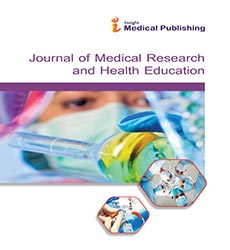Health Education Campaigns: Measuring Effectiveness and Outcomes
Sofia Jon*
Department of Public Health, University of Medicine and Pharmacy, Eftimie Murgu Square No. 2, 300041 Timisoara, Romania
*Corresponding author:
Sofia Jon,
Department of Public Health, University of Medicine and Pharmacy, Eftimie Murgu Square No. 2, 300041 Timisoara, Romania,
E-mail: Jon.sofi@umft.ro
Received date: February 03, 2025, Manuscript No. ipjmrhe-25-20730; Editor assigned date: February 05, 2025, PreQC No. ipjmrhe-25-20730 (PQ); Reviewed date: February 10, 25, QC No. ipjmrhe-25-20730; Revised date: February 17, 2025, Manuscript No. ipjmrhe-25-20730 (R); Published date: February 24, 2025, DOI: 10.36648/2393-8862.9.1.04
Citation: Jon S (2025) Health Education Campaigns: Measuring Effectiveness and Outcomes. J Med Res Health Educ Vol. 9 No.1:04
Introduction
Health education campaigns are a cornerstone of public health efforts aimed at promoting healthy behaviors, preventing disease and improving population-level outcomes. These campaigns employ targeted communication strategies to increase awareness, knowledge and adoption of health-promoting behaviors among diverse populations. They can address a wide range of issues, including vaccination, smoking cessation, nutrition, sexual and reproductive health, chronic disease prevention, hygiene and mental health. The success of these campaigns is not solely determined by message dissemination but by their ability to effect measurable behavioral change and improve health outcomes. Evaluating the effectiveness of health education campaigns is essential for optimizing resources, refining strategies and demonstrating public health impact. This requires a systematic approach to planning, implementation and measurement, incorporating both quantitative and qualitative indicators [1].
Description
The design and implementation of health education campaigns require a deep understanding of the target population, including demographics, cultural norms, literacy levels and prevailing health beliefs. Audience segmentation allows campaigns to tailor messages to specific groups, ensuring relevance and increasing the likelihood of engagement. For example, adolescents may respond better to social media-based interventions, while older adults may benefit from community workshops or print media. Developing clear, evidence-based messages is essential to convey accurate information, counter misinformation and motivate behavioral change. Campaigns should use multiple channels, such as television, radio, social media, community outreach and print materials, to maximize reach and reinforce key messages [2].
Measuring the effectiveness of health education campaigns involves evaluating both process indicators and outcome indicators. Process indicators assess the implementation and reach of the campaign, including the number of materials distributed, media impressions, social media engagement metrics, workshop attendance and participation rates. These indicators help determine whether the campaign is successfully reaching its intended audience and whether the delivery methods are effective. Process evaluation also includes assessing the fidelity of message delivery, consistency across different platforms and the engagement of local stakeholders, which are critical for ensuring accurate and uniform messaging [1].
Outcome indicators measure the impact of health education campaigns on knowledge, attitudes, behaviors and health outcomes. Knowledge assessments evaluate whether the target population has gained understanding of health issues, risk factors, preventive measures, or available services. Surveys, quizzes, focus groups and interviews are commonly used to measure changes in knowledge. Attitudinal changes are assessed by examining shifts in perceptions, beliefs and readiness to adopt health-promoting behaviors. Behavioral outcomes, the ultimate goal of most campaigns, assess actual changes in health-related actions, such as increased vaccination rates, reduced tobacco use, improved dietary habits, or adherence to medication regimens.
These outcomes may be measured through self-reported behaviors, clinical records, or public health surveillance data [2]. To establish the effectiveness of a campaign, it is important to consider both short-term and long-term impacts. Short-term outcomes, such as increased awareness or knowledge, are often easier to measure and provide immediate feedback on campaign performance. Long-term outcomes, such as reductions in disease incidence, improved health behaviors, or sustained lifestyle changes, require ongoing monitoring and evaluation. Combining short-term and long-term assessments provides a comprehensive understanding of campaign effectiveness and informs future interventions.
Quantitative and qualitative research methods are often used in combination to evaluate health education campaigns. Quantitative methods, such as pre- and post-campaign surveys, randomized controlled trials and epidemiological studies, provide measurable data on knowledge, behavior and health outcomes. Qualitative methods, including focus groups, in-depth interviews and community feedback, provide insights into the contextual factors, perceptions and barriers that influence the adoption of health behaviors. Mixed-methods evaluation allows campaign designers to interpret numerical data within the social, cultural and environmental context of the target population, leading to more effective program improvements.
Conclusion
Health education campaigns are powerful tools for promoting public health, preventing disease and improving population health outcomes. Measuring their effectiveness requires a systematic approach that includes process and outcome evaluation, encompassing knowledge acquisition, attitudinal shifts, behavioral change and health impact. Utilizing quantitative and qualitative methods, guided by behavioral theories and supported by digital analytics, allows for comprehensive assessment of campaign success.
Economic evaluation ensures optimal resource allocation and sustainability, while iterative feedback and community engagement improve relevance and effectiveness. By rigorously measuring outcomes, public health practitioners can refine strategies, enhance the impact of future campaigns and ultimately foster healthier, more informed communities. Effective evaluation not only demonstrates the value of health education initiatives but also ensures that they contribute meaningfully to the overarching goal of improved health and well-being.Acknowledgement
None.
Conflict of Interest
None.
References
- Loven J, Hoke HA, Lin CY, Lau A, Orlando DA, et al. (2013) Selective inhibition of tumour oncogenes by disruption of super- enhancers. Cell 153: 320-334.
Google Scholar Cross Ref Indexed at
- Chapuy B, McKeown MR, Lin CY, Monti S, Roemer MG, et al. (2013) Discovery and characterization of super-enhancer- associated dependencies in diffuse large B cell lymphoma. Cancer Cell 24: 777-90.
Open Access Journals
- Aquaculture & Veterinary Science
- Chemistry & Chemical Sciences
- Clinical Sciences
- Engineering
- General Science
- Genetics & Molecular Biology
- Health Care & Nursing
- Immunology & Microbiology
- Materials Science
- Mathematics & Physics
- Medical Sciences
- Neurology & Psychiatry
- Oncology & Cancer Science
- Pharmaceutical Sciences
